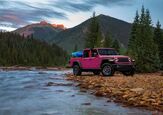Safety Regulators Already Looking At Tesla Robotaxi Driving Standards

Tesla’s debut of its driverless ride-hailing service in Austin has already attracted the attention of federal safety regulators.
Key Points
- NHTSA is reviewing multiple traffic incidents involving Tesla's new robotaxi service in Austin, including videos showing traffic violations like lane misuse and speeding, just days after the service's limited debut.
- Tesla's driverless rides are confined to a geofenced area with Tesla employees acting as in-vehicle safety monitors. Despite being billed as autonomous.
- The federal investigation and comparison to more established services like Waymo spotlight persistent concerns about Tesla’s Full Self-Driving system reliability and deployment readiness.
Just days after Tesla rolled out the invite-only program to select influencers and investors, the National Highway Traffic Safety Administration confirmed it is reviewing multiple incidents posted to social media that appear to show Tesla’s self-driving vehicles violating local traffic laws.
According to a report from Bloomberg, the videos posted online depict concerning behavior from the autonomous vehicles. One clip shows a Model Y robotaxi entering an intersection from a left-turn-only lane, pausing, then continuing into an unoccupied lane intended for oncoming traffic before correcting to the right side of the roadway across a double yellow line. NHTSA said other footage shows the vehicles exceeding posted speed limits in residential areas.
Tesla launched the service over the weekend with a small fleet of Model Y crossovers operating in a geofenced section of Austin. Rides are currently available only by invitation and will include a Tesla employee riding in the front passenger seat, as a safety monitor, for the foreseeable future.
Based on the safety monitor's positioning in the passenger seat, their ability to intervene in the vehicle's operation is unclear at best. Images of early rides show the supervisors poised with their hands near a switch on the passenger door, indicating their only real play is to activate a door-based emergency override system. Tesla has not publicly addressed whether the onboard monitors have access to a full range of emergency controls.
Unlike Waymo or Cruise, Tesla has launched this paid service with human monitors still onboard. The vehicles are limited to operation between 6 a.m. and midnight and avoid high-risk areas such as highways, airports, and complex intersections.
NHTSA confirmed it is gathering further details from Tesla and will determine if further action is needed. The agency also revealed that Tesla had invoked a federal law that "restricts NHTSA’s ability to publicly release what the companies label as confidential." Meaning the safety agency is not allowed to share any information Tesla provides regarding the investigation with the public. Awesome. NHTSA did say it is particularly concerned that Tesla is using its ‘Supervised Full Self-Driving’ for Robotaxi service while it is currently under active investigation after several serious accidents.
NHTSA has been investigating Tesla vehicles using Full Self-Driving software under conditions of reduced visibility since October. The probe covers 2.4 million Tesla vehicles equipped with FSD technology after four reported collisions, including a 2023 fatal crash. NHTSA confirmed its investigation into Tesla’s FSD-Supervised/Beta remains open.
Become an AutoGuide insider. Get the latest from the automotive world first by subscribing to our newsletter here.

An experienced automotive storyteller and accomplished photographer known for engaging and insightful content. Michael also brings a wealth of technical knowledge—he was part of the Ford GT program at Multimatic, oversaw a fleet of Audi TCR race cars, ziptied Lamborghini Super Trofeo cars back together, been over the wall during the Rolex 24, and worked in the intense world of IndyCar.
More by Michael Accardi




































Comments
Join the conversation